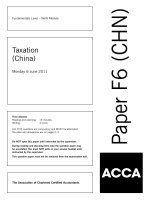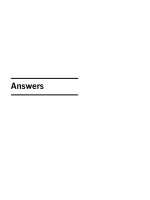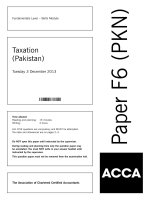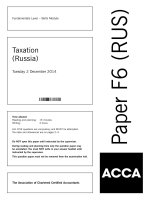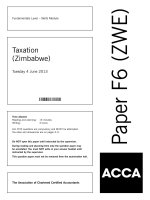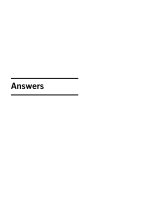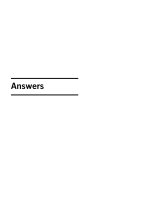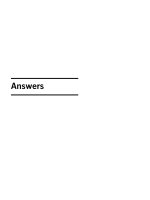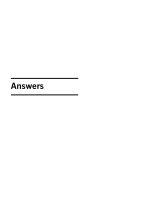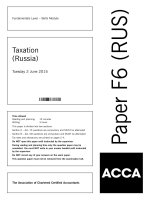ACCA f6 taxation russia 2012 jun question
Bạn đang xem bản rút gọn của tài liệu. Xem và tải ngay bản đầy đủ của tài liệu tại đây (277.08 KB, 13 trang )
Taxation
(Russia)
Tuesday 12 June 2012
Time allowed
Reading and planning:
Writing:
15 minutes
3 hours
ALL FIVE questions are compulsory and MUST be attempted.
Tax rates and allowances are on pages 2–4.
Do NOT open this paper until instructed by the supervisor.
During reading and planning time only the question paper may
be annotated. You must NOT write in your answer booklet until
instructed by the supervisor.
This question paper must not be removed from the examination hall.
The Association of Chartered Certified Accountants
Paper F6 (RUS)
Fundamentals Level – Skills Module
SUPPLEMENTARY INSTRUCTIONS
1. Calculations and workings need only be made to the nearest RR
2. The apportionment to interest should be made in calendar days
3. All apportionments should be made to the nearest month, unless the law requires otherwise
4. All workings should be shown
TAX RATES AND ALLOWANCES
The following tax rates and allowances are to be used in answering all questions on this paper unless the question
states otherwise.
Personal and children allowances
400 RR (up to 40,000 RR)
1,000 RR per child (up to 280,000 RR)
Standard personal allowance
Children allowance
General limitation on ‘property’ allowance
Investments in residential property and land for tax purposes
2,000,000 RR (upper limit)
Statutory exclusions from taxable income
4,000 RR (upper limit)
4,000 RR (upper limit)
4,000 RR (upper limit)
Prizes and awards
Gifts at work
Support payments
Maximum limit for social deductions listed below
120,000 RR (upper limit)
(medical, personal educational, non-state pension insurance, voluntary pension insurance and additional insurance
contributions for the accumulated part of labour pension – subject to certain conditions set out in the law)
Educational deduction for children
Professional deduction –
–
–
–
50,000 RR (upper limit)
general
for architects
for music writer
for sculptor
20%
30%
40%
40%
Charity deduction
up to 25% of income
Gains on property sales
1,000,000 RR (upper limit)
250,000 RR (upper limit)
– immovable property
– movable property
Housing allowance (deduction)
2,000,000 RR (upper limit)
Statutory per diem rate for personal income tax
– for domestic business trips
– for foreign business trips
700 RR per day
2,500 RR per day
Threshold interest rates for personal income tax purposes
Rouble bank deposits
CB refinancing rate increased by 5%
Foreign currency bank deposits
9%
Rouble loans
2/3 of the CB refinancing rate
Foreign currency loans
9%
Threshold interest rates for profits tax purposes
Foreign currency loans
Rouble loans received
0.8 of the CBR refinancing rate
1.8 of the CBR refinancing rate
2
Single threshold for social insurance contributions for the year 2012 (several categories of insurance contributions
subject to special incentives and reduced rates are not examined)
For employers (general) and individual entrepreneurs
Income amount
up to 512,000 RR
Rate
30%
For employers (licences, copyrights, civil contracts)
up to 512,000 RR
27.1%
Expenses for profits tax purposes
Voluntary medical insurance expenses (subject to conditions set out in the law) are limited to 6% of labour costs.
Voluntary life insurance expenses (subject to conditions set out in the law) are limited to 12% of labour costs.
Voluntary personal insurance against accidents at work resulting in death or permanent physical disability are limited to
15,000 RR per employee per annum.
Certain advertising expenses are limited to 1% of sales revenue.
Reimbursement of interest on employees’ mortgage loans is limited to 3% of labour costs.
Entertainment expenses (subject to conditions set out in the law) are limited to 4% of labour costs for the reporting period.
Special depreciation ratios
Non-current assets received under financial leasing
3 (upper limit)
Historic costs of depreciable non-current assets
40,000 RR per unit (minimum)
Allowances for receivables
General limitation
Aged 0 to 44 days
Aged 45 to 90 days
Aged more than 90 days
10% of sales
0% of receivables
50% of receivables
100% of receivables
Standard
Exports and sales to diplomatic missions
Value added tax (VAT) rates
18%
0%
Limit for VAT – exempt promo presents
100 RR (upper limit)
General profits tax rate
20%
Tax on dividends for residents
Tax on dividends for foreign companies
9%
15%
Property tax rate
2.2%
Basic rate
Higher rate
Personal income tax rates
13%
35%
Tax on dividends for residents
9%
3
[P.T.O.
1 January to 30 April 2012
1 May to 30 September 2012
1 October to 31 December 2012
Central Bank refinancing rates (notional)
25%
15%
10%
Number of calendar days in calendar months for the year 2012
January
31
February
29
March
31
April
30
May
31
June
30
July
31
August
31
September
30
October
31
November
30
December
31
4
ALL FIVE questions are compulsory and MUST be attempted
1
ZAO Excelsior CIS (‘Excelsior’) is a company engaged in providing legal, tax and other consulting services both in
Russia and in CIS countries. Excelsior is 85% owned by a Russian company ZAO Cellis and 15% by an Italian
company Vicotti S.p.A.
Excelsior always applies the accruals method for both value added tax (VAT) and corporate profits tax purposes and
uses a quarterly profits tax reporting period.
In respect of non-current assets, Excelsior applies the non-linear method of depreciation for profits tax purposes and
its tax policy for the year 2012 stipulates its right to an immediate 30% write-off on non-current asset cost. Excelsior
uses the standard social insurance contribution rates without any incentives.
Regarding direct costs, Excelsior’s tax policy provides for the immediate write-off of its direct expenses in the relevant
reporting period without allocation
The following information is available for the year 2012. All amounts are inclusive of VAT unless stated otherwise. All
domestic services provided to clients in Russia during the year 2012 were subject to VAT at the standard rate.
Sales, cash collections and prepayments for the year 2012 (in RR):
Domestic sales of consulting services
Services to diplomatic missions (0% VAT rate)
Sales receivables
Prepayments from domestic clients
174,345,000
7,092,000
1 January
14,514,000
8,496,000
31 December
15,965,400
9,090,720
Direct costs of services (in RR)
Materials included in cost of sales (all purchased in 2012)
21,830,000
VAT invoices were received for the value of 70% of these purchases.
Direct remuneration
The table below sets out details of the remuneration paid by Excelsior for the year 2012.
Job title
Director
Associate
Office assistant
Annual gross salary
per person accrued
and paid in 2012
RR
4,771,200
2,003,904
1,202,342
Number of
persons
2
20
7
Legal status
Direct or
administrative cost
Employee
Employee
Civil law contractor
Direct
Direct
Administrative
Direct IT equipment by category:
Category
of equipment
Notebook computers
Quantity
Historic cost per
unit in RR
(VAT inclusive)
45
29,500
Date put
into use
March 2012
Monthly
non-linear tax
depreciation rate
for IT non-current assets
5.6%
Indirect expenses:
In addition to the payments set out above, Excelsior provided both voluntary medical insurance for its permanent
employees for 5,940,000 RR and voluntary medical insurance for their relatives for 2,970,000 RR in the year 2012.
Voluntary personal insurance against accident at work was also offered to all permanent employees. The total
insurance premium paid by Excelsior for this accident at work insurance in the year 2012 was equal to
3,960,000 RR.
In both cases, the term of the insurance agreement was one year.
5
[P.T.O.
Software licences
During the year 2012 Excelsior purchased seven non-exclusive software licences for the total value of 119,000 RR
(17,000 RR each), free of VAT.
Advertising expenses
Excelsior incurred 9,153,260 RR for advertising placement in the press. In addition, 3,268,600 RR was spent on
the distribution of different advertising promo presents to clients during the year 2012. The cost of each unit of promo
presents distributed varied from 200 RR to 1,000 RR. VAT invoices have been received for the value of 65% and
75% respectively of these expenses.
Allowances for receivables
Excelsior decided to post an allowance for receivables as at 31 December 2012. Excelsior had not created any
allowances for receivables before this, but did so in 2012 because it wanted to write off a receivable from the domestic
debtor Lomier in the amount of 700,000 RR (net of VAT). This receivable was overdue for the period of two and a
half years as the debtor had disappeared and Excelsior’s lawyers have failed to find out any reference to him.
The results of verification of Excelsior’s receivables as at 31 December 2012 revealed that receivables in the amount
of 6,136,000 RR (including VAT) were overdue for 55 days and of 5,133,000 RR (including VAT) for the period of
115 days.
Another receivable of 436,600 RR (including VAT) was written off in the year 2012. This receivable was confirmed
by Excelsior’s lawyers as an uncollectable receivable due to the liquidation procedure undergone by the customer. All
confirming documents were kept by the company.
Interest expense
On 7 October 2012 Excelsior received a five-year loan for 1,700,000 EUR from Vicotti S.p.A. with interest at the rate
of 7% per annum. Interest is payable on the last date of each quarter (i.e. the first interest instalment was payable
on 31 December 2012).
Tax losses brought forward
At 1 January 2012 Excelsior had the following unused tax losses:
2009 year – 400,000 RR
2010 year – 1,500,000 RR
6
Required:
(a) Assuming that all the expenses referred to in the scenario are properly confirmed by necessary documents,
calculate the taxable profit and corporate profits tax liability of ZAO Excelsior CIS for the year 2012. Show
separately all elements of the taxable income and deductible expenses and identify any non-deductible
expenses (calculations of non-deductible amounts are not required).
Notes:
1. For social insurance contribution purposes ignore all expenses other than salaries.
2. Ignore property tax.
3. The following notional EUR/RR exchange rates are to be used:
1 October 2012
7 October 2012
31 October 2012
1 November 2012
30 November 2012
1 December 2012
31 December 2012
47.5
46.5
47.0
48.5
49.5
48.0
49.0
(19 marks)
(b) Recalculate the aggregate direct cost amount to be used in the calculation of taxable profit, if ZAO Excelsior
CIS stipulates in its tax policy that direct costs should be allocated based on the services completeness ratio
by reference to when the acts of acceptances were signed.
Note: You should assume that:
1. acts of acceptance for services rendered had been signed by domestic customers for 139,706,490 RR
(VAT inclusive) out of the total services charged on services-in-progress account of 181,437,000 RR for
the year 2012; and
2. Excelsior applies the FIFO method, and as at 31 December 2011 domestic services with the charge-out
value of 43,660,000 RR remained on account (not accepted by the clients) and direct expenses in the
inventory balance were 24,430,000 RR (net of VAT).
(3 marks)
(c) Calculate ZAO Excelsior CIS’s value added tax (VAT) liability for the year 2012. Show separately all elements
of output/input VAT.
(8 marks)
(30 marks)
7
[P.T.O.
2
Vladislav works as an insurance agent for the insurance company Agrimon. He is married to Alina and they have one
son and two daughters aged seven, ten and 15 years respectively. Vladislav’s gross monthly salary is 97,000 RR.
On 14 February 2012 Agrimon paid for voluntary medical insurance policies for its employees under an annual
agreement at a 20% discount to the market value of 20,000 RR per person. In addition, Vladislav has chosen the
following types of insurance provided by Agrimon at its own account to its employees:
–
voluntary medical insurance for the children priced at 15,000 RR each;
–
voluntary property insurance against fire of their summer house with the premium of 21,000 RR. The insured
value of the summer house is 220,000 RR.
After celebrating the May holidays with fireworks, the summer house was damaged from fire. The actual costs of the
repair works confirmed by relevant documents were 175,000 RR. The insurance company (Agrimon) has accepted
this incident as complete destruction of the property, being covered by the property insurance policy, and paid the full
insured value to Vladislav in 2012.
In 2012 Vladislav paid 37,000 RR for the education of his elder daughter at the skating school and 14,000 RR out
of 42,000 RR for his son’s professional swimming school respectively. The remainder of the 42,000 RR was paid by
his wife Alina.
All the above educational schools are daytime classes and licensed institutions under the law of the Russian
Federation.
In addition, Vladislav decided to pay contributions of 5,000 RR under a voluntary pension agreement with a
non-pension fund for himself. In 2012 he also paid 22,000 RR for the medical treatment of his mother.
During the year 2012 Vladislav received the following additional benefits from Agrimon:
–
Sales acceleration training in St. Petersburg in April 2012, costing 85,000 RR
–
Professional photocamera in May 2012 as a gift on his birthday for the value of 27,000 RR
–
Material donation as a reimbursement of his medical treatment in June 2012 for the value of 7,000 RR
On 25 February 2012 Vladislav received a car as a gift from his mother. The market value of the car is 420,000 RR.
On 12 May 2012 as a result of participating in a ‘Collect and get’ promotion campaign arranged by the company
GGG, Vladislav won a trip to Croatia as an advertising prize for the value of 50,000 RR.
Also in May 2012 Vladislav and Alina decided to build a new residential house on the plot of land, valued at
1,700,000 RR, received by Alina as an inheritance in February 2012.
In 2012 Vladislav invested 700,000 RR from his personal savings in the construction of this residential house. In
addition, on 13 June 2012 Agrimon provided him with a 1,150,000 RR mortgage loan at the interest rate of 3% per
annum for a five-year period. Interest is payable on this mortgage loan starting from the year 2013.
Alina works as a creative editor for the TV company YUT. Alina’s gross salary is 80,000 RR per month, except for the
month of January when she received 35,000 RR gross.
Alina received the following benefits from her employer during the year 2012:
–
February 2012 – free of charge vouchers for the canteen for the value of 12,000 RR which are not stipulated in
the labour agreement
–
March 2012 – gift certificate for the value of 7,000 RR as a gift for Women’s Day
–
April 2012 – 350,000 RR net was credited to her account as a bonus for the year 2011, which was accrued in
December 2011
–
June 2012 – free of charge visits to the swimming pool for three months with the value of 15,000 RR
Alina decided to take a loan of 1,000,000 RR for her personal education (needs) from the bank on 23 October 2012.
The interest rate for the loan is 5% per annum for a seven-year period. Interest is payable on this loan on a quarterly
basis on the last date of each quarter (i.e. interest for the fourth quarter of 2012 is payable on 31 December 2012).
The loan principal amount is to be repaid at the end of the loan period, not by instalments.
8
Vladislav and Alina received joint ownership rights for their newly constructed house in early December 2012.
Vladislav managed to submit to his employer, Agrimon, the document from the tax authority confirming his entitlement
to property allowance in December 2012. Vladislav has never used his property allowance before, whereas Alina has
already used it.
Required:
Assuming that all the expenses incurred by Vladislav and Alina in 2012 are confirmed with proper supporting
documents:
(a) Calculate the personal income tax of Vladislav withheld at source by his employer for the year 2012,
assuming that Vladislav has asked Agrimon for all possible deductions to be given.
(10 marks)
(b) Calculate the final settlement of Vladislav’s personal income tax liability (additional payment or refund) upon
submission of his 2012 personal income tax return.
(6 marks)
(c) Calculate the final settlement of Alina’s personal income tax liability for the year 2012.
(9 marks)
Notes:
1. To the extent possible use all the personal income tax deductions that are potentially available to Vladislav
and Alina.
2. State separately the amounts of all personal income tax deductions claimed by Vladislav and Alina for the year
2012 and the deductions (if any) carried forward to future years.
3. Ignore social insurance contributions and value added tax (VAT).
(25 marks)
9
[P.T.O.
3
(a) During the year 2012 ZAO Bars (‘Bars’) booked the following sales in the process of its operating activity.
Invoice for consulting services to OOO Georgin (‘Georgin’) issued as of 5 February 2012 for the value of
3,835 notional units, including value added tax (VAT). Georgin booked this invoice on 12 February 2012 in its
accounting system.
Based on the agreement with Bars, one notional unit is equal to one USD, invoices are payable in roubles at the
USD/RR Central Bank exchange rate on the date of payment. Payment terms are 30 days from the date of
invoice.
On 3 March 2012 the above invoice was paid by Georgin to Bars.
In early April 2012 Bars reviewed its operations for Quarter 1 of the year 2012 and realised that cost of service
for the invoice issued as of 5 February 2012 should be decreased by a discount of 354 notional units including
VAT.
On 3 April 2012 Bars notified its customer Georgin by way of sending the special agreement on providing the
above discount for this service. Georgin has signed this agreement.
On 7 April 2012 Bars issued an amended VAT invoice taking into account the above discount.
Required:
(i)
Calculate ZAO Bars output VAT for Quarter 1 of the year 2012, state the amount of the summing
difference and its impact (if any) on the output VAT.
(3 marks)
(ii) Calculate the impact of the amended VAT invoice on both the output VAT and the input VAT for Quarter
2 of the year 2012 for each of OOO Georgin and ZAO Bars respectively.
(2 marks)
(iii) State the general rule for determining the VAT claw-back date and explain if the VAT claw-back date for
OOO Georgin would change if ZAO Bars had notified it about the discount on 30 March 2012, instead
of 3 April 2012. Assume all other data in the scenario remained unchanged.
(3 marks)
(iv) State the period when the amended VAT invoice should be issued.
Note: The following USD/RR exchange rates (notional) are to be used:
5 February 2012
12 February 2012
29 February 2012
3 March 2012
3 April 2012
7 April 2012
29
30.5
30
31
31.5
32
10
(1 mark)
(b) OOO Antic (‘Antic’) conducts activities that are 100% subject to value added tax (VAT) at the general rate.
Antic’s treasury manager reviewed its accounts receivable as of 31 May 2012 and, based on the market analysis,
decided to sell the accounts receivable from Gera and Dionissiy to the factoring company Zevs, on the following
conditions:
Antic accounts receivable sold to Zevs (all amounts are inclusive of VAT):
Name
of customer
Gera
Dionissiy
Date of due
payment
27 November 2011
12 October 2011
Amount
RR
8,555,000
7,262,900
Date of sale
of receivable
2 June 2012
7 June 2012
Proceeds from sale
of receivable, RR
9,410,500
6,681,868
Regarding another receivable from company Heracle, the following data is available:
A shipment was made to Heracle on 5 May 2012 for the value of 3,068,000 RR (including VAT).
On 10 May 2012 Heracle submitted to Antic a promissory note with the par value of 3,068,000 RR, a
redemption date of 45 days from the date of issue, and annual interest on redemption of 30%
Required:
Calculate the output VAT for OOO Antic for Quarter 2 of the year 2012, based on the above transactions.
Show separately the elements of output VAT for each item.
(3 marks)
(c) In 2012 OOO Chevalier (Chevalier) started to export goods to Slovenia under a direct contract with a Slovenian
customer. The first export shipment and customs clearance took place on 5 April 2012. The total value of this
first shipment was 1,200,000 EUR.
The Slovenian customer paid Chevalier 1,000,000 EUR on 30 May 2012 and the remaining balance of
200,000 EUR was paid on 7 June 2012.
The costs incurred by Chevalier before the date of shipment and related to this export shipment were
17,936,000 RR (including value added tax (VAT)) at the general rate.
Chevalier failed to submit the package of documents confirming export by the due date of 2 October 2012.
Required:
(i)
Calculate the amount of VAT payable to the budget by OOO Chevalier for Quarter 2 due to the
unconfirmed export;
(1 mark)
(ii) Calculate the late interest penalty payable by OOO Chevalier for the period up to 30 September 2012.
(2 marks)
Note: The following RR/EUR exchange rates (notional) are to be used:
5 April 2012
30 April 2012
30 May 2012
7 June 2012
2 October 2012
31 December 2012
40.5
39
40
39.5
41
41.5
(15 marks)
11
[P.T.O.
4
(a) Stas Solnechnyi is an individual entrepreneur, who runs his own café ‘Lutch’.
In January 2012 Lutch’s bank account was credited with 14,986 RR (including value added tax (VAT)) as a final
payment for the birthday celebrated in this café in December 2011.
Revenue received in cash during the year 2012 was equal to 1,416,000 RR (including VAT).
The expenses incurred for the café’s employees for the year 2012 were as follows:
Gross monthly salary of head-cook – 30,000 RR
Gross monthly salaries of two waiters – 13,000 RR per each
Gross monthly salary of charwoman – 5,000 RR
All four employees worked in the café for all of the year 2012.
In compliance with the labour agreements, 50% salary should be transferred to the employee’s account on the
15th date and other 50% on the 27th date of each month respectively.
In addition, in May 2012 Stas sold one computer which had been acquired in December 2009 at the historic
cost of 53,100 RR (including VAT) and depreciated over three years using the linear method. The sales proceeds
were received in June 2012 in the amount of 8,260 RR (including VAT).
Social insurance contributions for Stas’ own income as an individual entrepreneur were 12,003 RR in the year
2012.
Required:
(i)
Calculate Stas Solnechnyi’s personal income tax liability for the year 2012 in his capacity of individual
entrepreneur, assuming that Stas used the professional deduction in the amount of actual expenses
incurred.
(7 marks)
(ii) Calculate Stas Solnechnyi’s taxable income for the year 2012 in his capacity of individual entrepreneur
assuming that Stas cannot confirm his actual expenses.
Note: you are not required to calculate the tax liability in part (ii).
(1 mark)
(b) Victor Ozerov approached his employer, Complex, with the request for a loan of 100,000 RR. Complex is
prepared to provide the loan to Victor under one of the following alternative sets of terms of conditions:
(1) an interest-free rouble loan which is to be repaid on 30 April 2012;
(2) a rouble loan at an annual rate of interest of 3%, with interest to be paid on 30 June and 31 December
respectively and the principal amount to be repaid only in 2013.
Whichever alternative is chosen by Victor, the loan will be provided to him on 28 February 2012.
Required:
(i)
Assuming the loan was for Victor Ozerov’s personal consumption needs, calculate the personal income
tax impact for Victor of each of the loan alternatives ((1) and (2)) proposed by Complex;
(6 marks)
(ii) Assuming the loan was for the purpose of Victor Ozerov’s acquisition of a residential apartment, explain
the impact on Victor’s personal income tax for the year 2012 if he was granted the loan at 3% interest
(alternative (2)). Victor has never used his housing allowance before.
(1 mark)
(15 marks)
12
5
(a) OOO Rakurs has the following accounting data (in RR) regarding its non-current assets in 2012:
Booking value
Depreciation
1 January
870,000
420,000
1 February
920,000
490,000
1 March
1,530,000
610,000
1 April
1,710,000
680,000
Required:
Calculate OOO Rakurs’ advance property tax payment for Quarter 1 of the year 2012.
(3 marks)
(b) Vasiliy Razumov works as a freelance sculptor. During the year 2012 he concluded an author’s agreement with
the company Stroymost for creating his new composition for the city exhibition for the remuneration of
1,250,000 RR. Vasiliy’s actual expenses incurred in the year 2012 in the course of this work were
770,000 RR. All expenses are confirmed by source documents.
Required:
(i)
Calculate Vasiliy Razumov’s social insurance contributions base for the year 2012 for each of the options
available to him;
(4 marks)
(ii) State what Vasiliy Razumov should do to receive deduction at source by Stroymost.
(1 mark)
(c) OOO Fialka (‘Fialka’) is 45% owned by OOO Geran (‘Geran’). In its turn, Geran is jointly owned by two foreign
companies: Begonia (60%) and Barvinok (40%).
Fialka requires debt financing of 2,700,000 EUR. The debt financing could be provided by either Begonia or
Barvinok. The required amount will be received by Fialka on 15 May 2012. The interest rate will be 3% per
annum and interest will be payable on a quarterly basis on the first day of the following quarter. Interest is not
compound.
The following forecasted data of Fialka’s assets and liabilities as at 30 June 2012, including any accrued interest
on the debt financing, is available:
Assets
Liabilities
Including tax liabilities
117,000,000 RR
87,000,000 RR
7,520,700 RR
Required:
Prepare calculations to show the tax effect of each of the two debt financing options available to OOO Fialka
for Quarter 2 of the year 2012 and state which company (Begonia or Barvinok) would be the more tax
efficient provider of the debt financing.
Note: The following EUR/RR exchange rates (notional) are to be used:
1 May 2012
15 May 2012
31 May 2012
1 June 2012
30 June 2012
40.5
41.5
42.0
42.5
43.0
(7 marks)
(15 marks)
End of Question Paper
13
